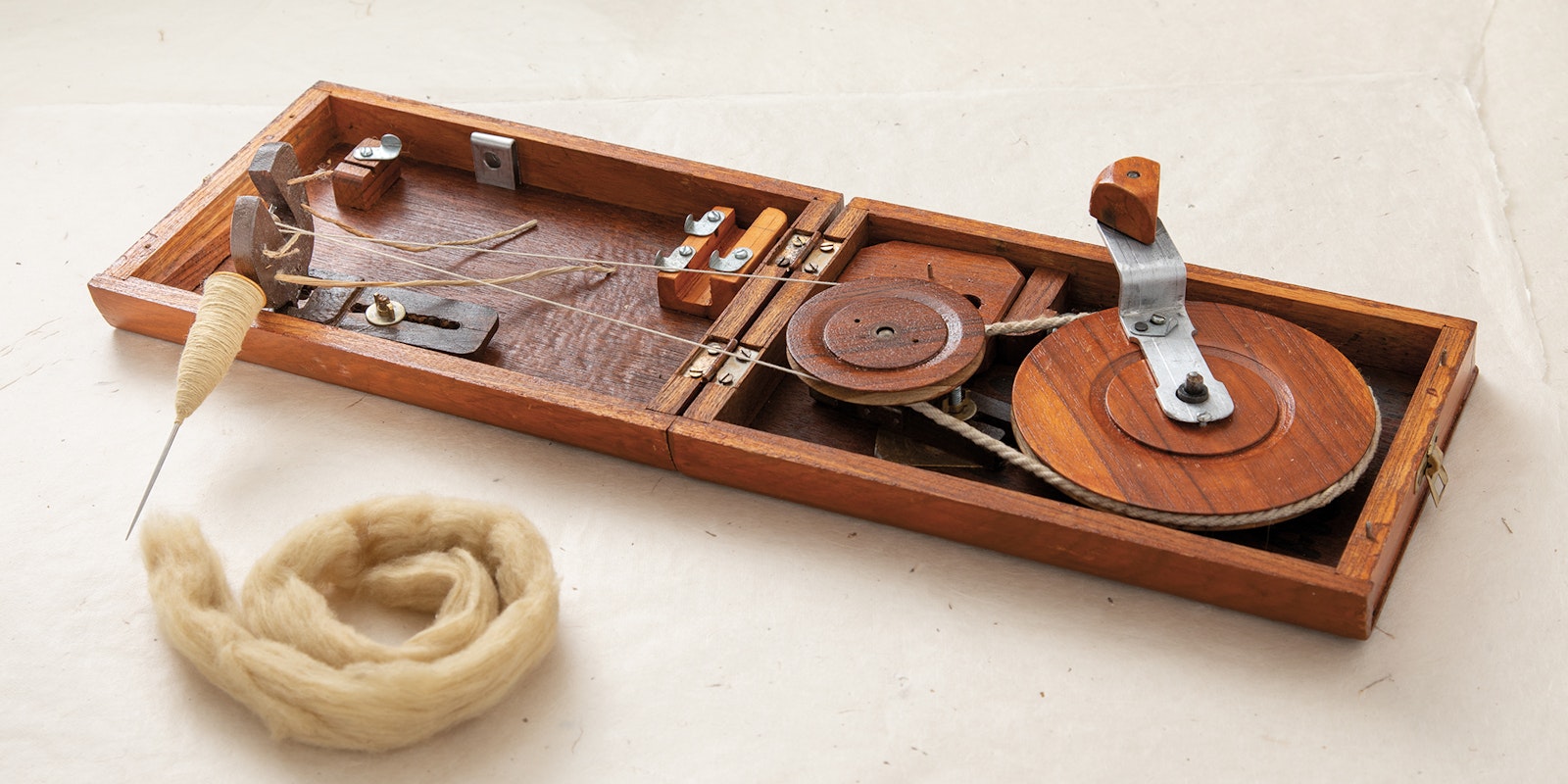Curiosity, a strong motivating factor in any journey, inspired me to veer off my wool- and wheel-spinning path to explore charkhas. When visiting the Gandhi Ashram Museum at Sabarmati, located in Ahmedabad, India, I saw one of Mahatma Gandhi’s charkhas on display. As I looked at it, I was astonished at how different it was compared to the spinning tools I knew so well. However, it has taken me another seven years and more sightings of similar spinning devices in China and Japan before I succumbed to the unique charms of these spinners.
Step One: Research
For me, part of the allure of a new-to-me spinning material or tool is learning about its history, political background, and material culture. In India, the term charkha refers to spinning wheels large and small, and the term is now used more broadly to describe driven-spindle wheels from other regions as well. There are many styles ranging from the traditional form of a moderate-size wheel to accelerated charkhas that fit into a box the size of a briefcase or hardcover book. Typically, the wheel is turned with one hand as the other hand drafts the fiber that is spun off the tip of a sharp spindle shaft.
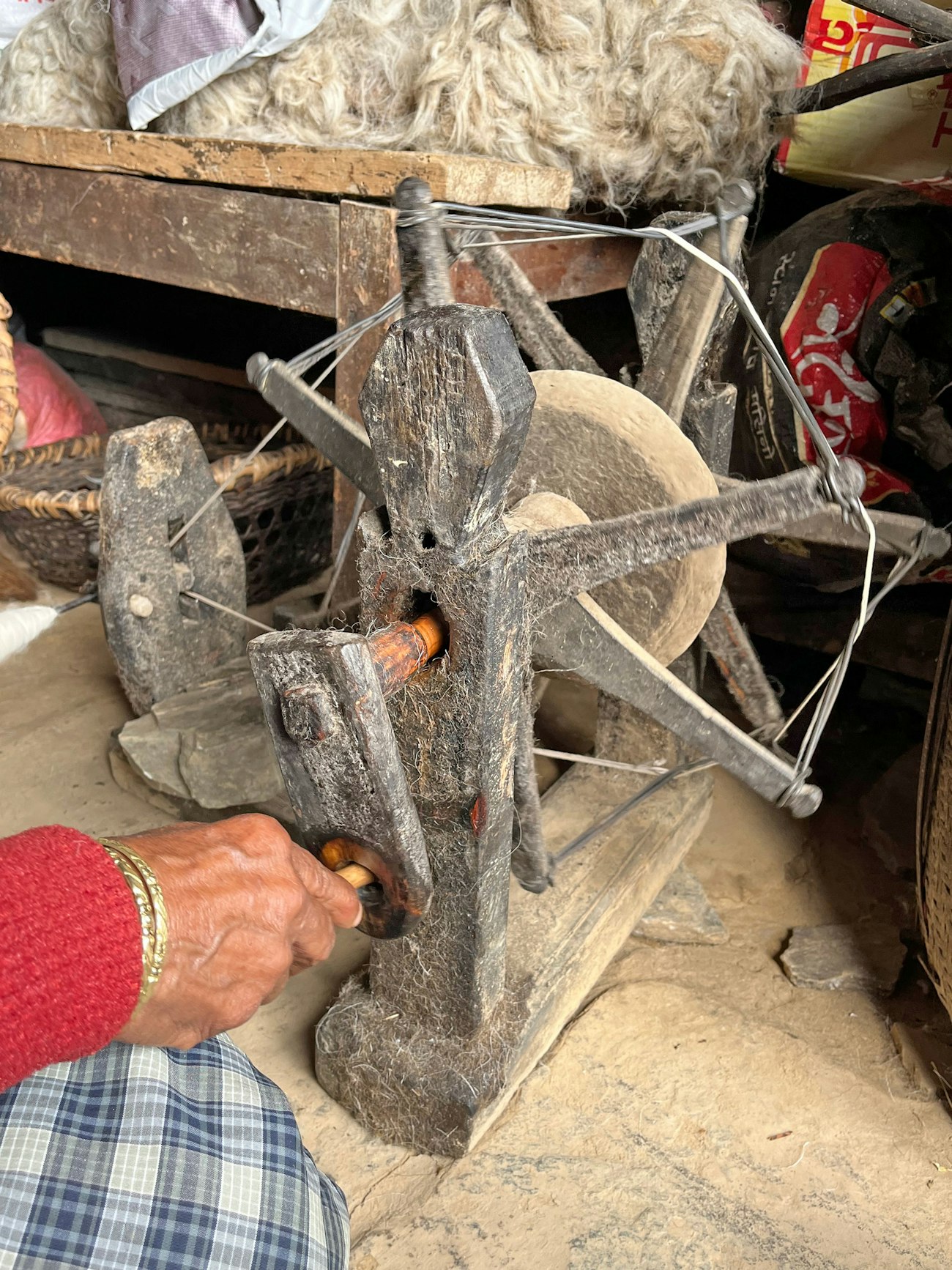 A dowel handle is used to spin the wheel on this charkha from Ghandruk, a village in Nepal. Photo by Karen Brock
A dowel handle is used to spin the wheel on this charkha from Ghandruk, a village in Nepal. Photo by Karen Brock
Due to the high speed of twist insertion associated with charkhas, they are considered ideal for spinning very short-staple fibers such as cotton, which has long been grown in India. As I sought to understand the charkha’s place in India, given it was the first place I saw this type of spinning device, I looked for research into the earliest uses of the spinning wheel or charkha.
In the introduction to their book Cotton: Origin, History, Technology, and Production, editors Smith and Cothren state, “The first improvement in spinning technology was the spinning wheel, which was invented in India between 500 and 1000 CE.” In A History of Textiles, Wilson says that the spinning wheel was developed in India around 750 CE when “the spindle was mounted on a frame and rotated by turning a wheel that held a cord attached to the spindle.”
Charkhas in the Twentieth Century
The politics attached to the charkha come from Gandhi’s involvement in India’s independence movement from the 1920s through the 1940s. As a means of countering British economics in India and establishing a symbol of resistance easily acceptable to Indians, he chose khadi cloth. Khadi is a simple cloth, typically cotton, made from handspun, handwoven fiber. He chose khadi to represent the new India, and as Rohini notes, “Khadi was to be an agent of change for providing livelihood, self-sufficiency, and at a moral plane, inculcate virtues like patience.” The charkha, or common spinning wheel, was integral to the production of khadi cloth.
However, the spinning wheel used day to day by millions of Indians was not easy to set up or move. To ameliorate this problem, Gandhi held a contest in July 1929 to design a spinning wheel that was small, lightweight, and portable. The prize-winning book-size charkha is the one he took with him to jail. It is also the one that we are most familiar with in North America today.
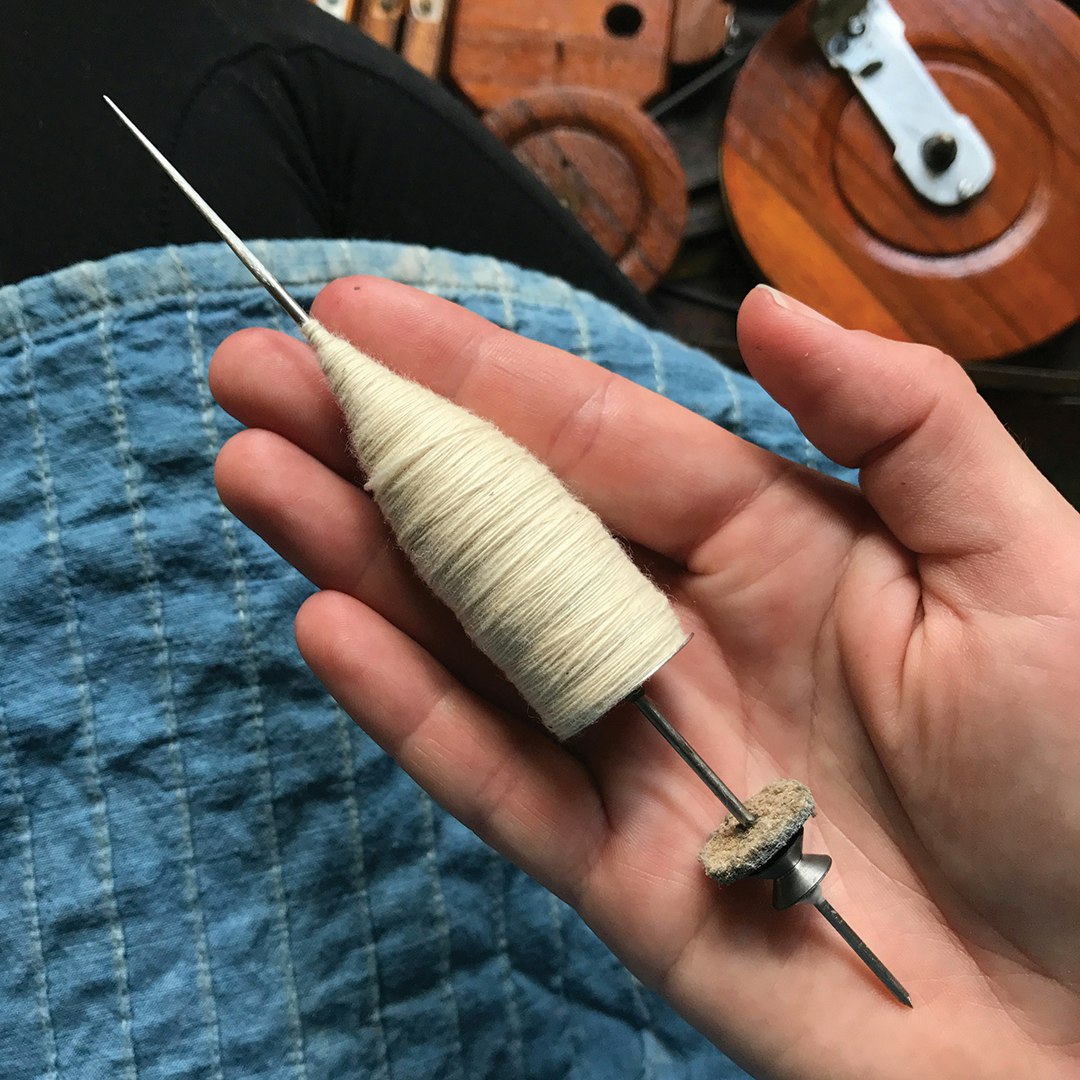 A spindle full of cotton. Photo by Kate Larson
A spindle full of cotton. Photo by Kate Larson
Step Two: Skill Building
After researching a new-to-me tool, in this case the charkha, tension rises as I think about trying to gain the skills necessary to work with it. This part of the learning process for me is akin to reading about a journey and then going out and buying the tickets. A charkha requires the spinner to learn to “spin off the tip.” This means that during spinning, the spinner changes the angle of the newly spun yarn so that it either does not wind on and accumulates twist, or it stops accumulating twist and can then be wound onto the spindle.
I decided to start my learning process using a supported spindle, but other spinners may just want to jump in and try the charkha directly. I chose to start with the Indian takli, a low-whorl supported spindle. It is supported because its bottom tip rests on a surface, such as a small bowl, during spinning. A takli has a heavier whorl than a similarly sized suspended spindle, which gives the spindle a longer period of rotation before slowing. Because the spindle is supported, the added weight does not add tension to the yarn as it forms.
In addition to patience and perseverance, I learned the importance of twist angle for ensuring the amount of twist needed to keep the fiber from drifting apart. I learned to make cotton punis for easier spinning. And after leaving a lot of cotton wisps around the house, I finally gained enough confidence to search for my next step toward charkha spinning—using other supported spindles such as Russian and Tibetan.
Learning to use Russian and Tibetan spindles is not a required next step, but I wanted to feel more comfortable with spinning short fibers before I tackled charkha spinning. And on any journey, if you don’t take some side roads, you’ll never know what you might find. All the spinning skills I learned from using a takli were put to use, and I became much more aware of how the fiber twisted and popped off the spindle tip to become yarn because the Russian and Tibetan spindles’ pointed shafts made this very easy to see. I explored yak down, bison down, and even cotton.
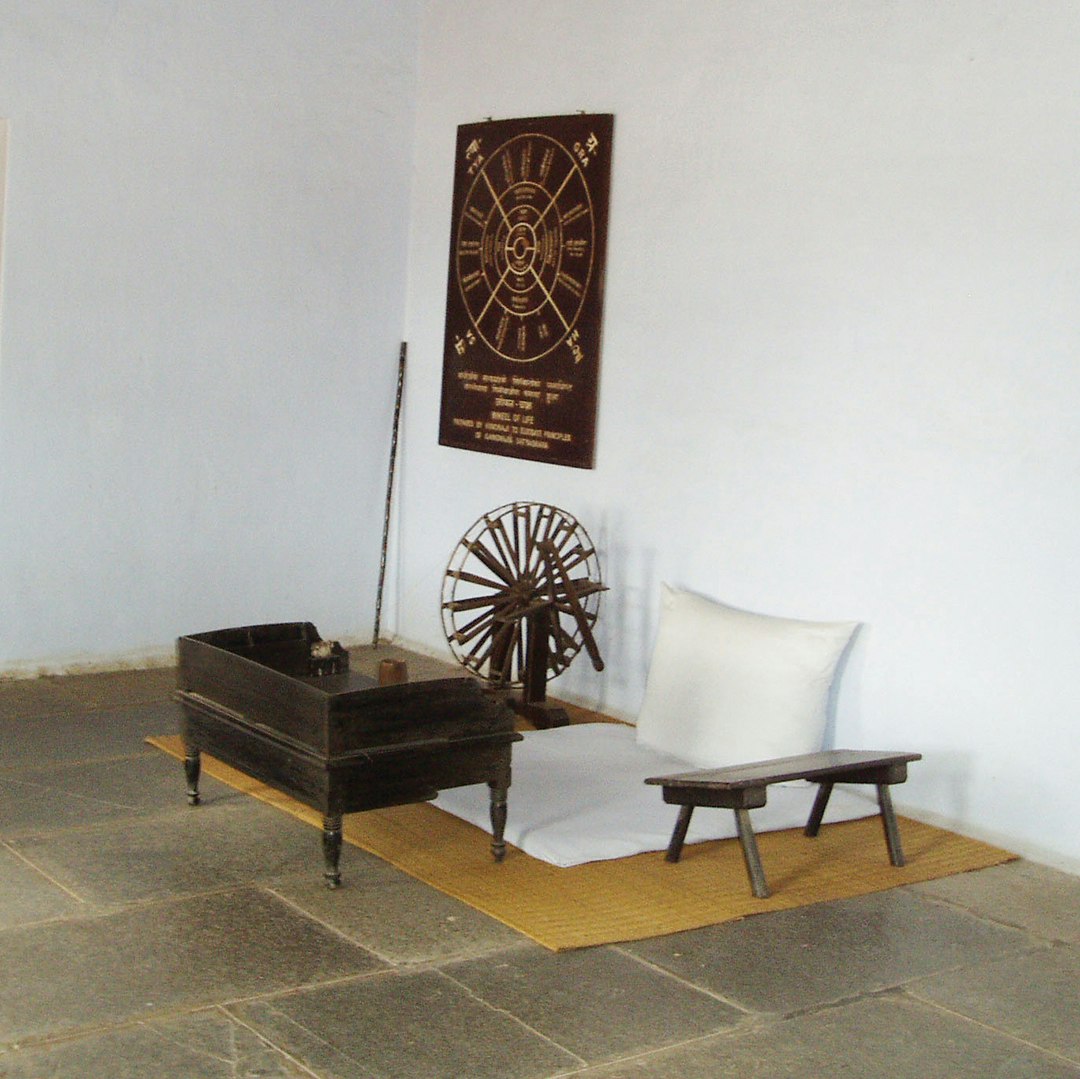 Joanne was able to see one of Gandhi’s traditional charkhas at the Gandhi Ashram in Ahmedabad, Gujarat, India. Photo by Joanne Nakonechny, courtesy of Gandhi Ashram
Joanne was able to see one of Gandhi’s traditional charkhas at the Gandhi Ashram in Ahmedabad, Gujarat, India. Photo by Joanne Nakonechny, courtesy of Gandhi Ashram
Love at First Spin?
The next step in my journey involved traveling in physical space rather than in a comfy armchair at home. I signed up for the Level 3 Spinner course in the Olds College Master Spinner Certificate program in Alberta, Canada. During my course, and after spinning cotton on my Ashford Joy spinning wheel, my moment came. Instructor Michelle Boyd had a briefcase-size charkha and offered each of us a chance to try it. My first reaction after beginning to spin was, “Argh! How can I possibly keep turning the wheel with one hand and use the other hand to draft and spin?” My time quickly expired for spinning on the class charkha, and I felt a grim and growing determination to get my own and make it work for me. I could see the possibilities, and my experience with supported spindles left me no doubt I could do it, but I definitely needed time and practice.
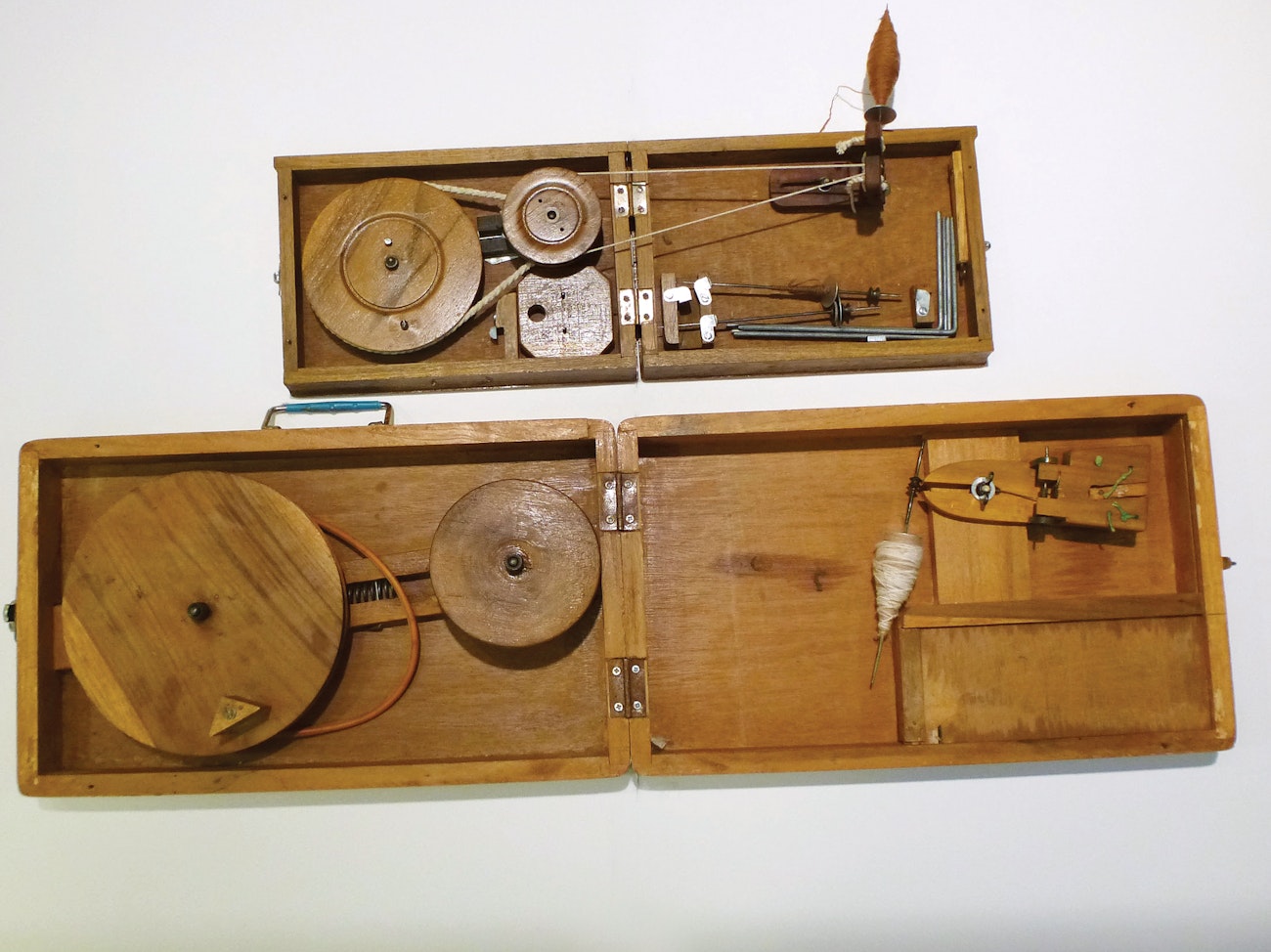 Joanne’s briefcase charkha (bottom) and book charkha (above). The briefcase-style is 31½" when open, and the book charkha is 20" when open. Photo by Joanne Nakonechny
Joanne’s briefcase charkha (bottom) and book charkha (above). The briefcase-style is 31½" when open, and the book charkha is 20" when open. Photo by Joanne Nakonechny
Step Three: Charkha Buying, Tuning, and More Buying
Surprise is usually a foregone conclusion in any journey, and I found it in this leg of the trek as I looked for reasonably priced charkhas to buy. My sister, Carole, was going traveling in India, and she agreed to bring back a charkha. I found an address in New Delhi where she could buy one. I felt that a little challenge just spiced up her journey, but she was not so sure. I specified a briefcase size, telling her I couldn’t possibly manage a book-size one. It was a sister challenge that almost defeated her, but in the end, she managed to find one at an artisan craft complex. She mailed it to me, and it arrived with all sorts of stamps on the package and looked delightfully enticing. I opened it, looked at it, and then realized I had no idea how to set it up and make it work. Fortunately, Leslie Green, a fellow Richmond Weavers and Spinners Guild member, knew much more about charkhas and taught two of us how to make our charkhas functional. I also saw that her smaller book-size charkha was perfect for traveling, while my larger size was more for home and workshop use. I was off to Ravelry, searching the spinning groups for book charkhas posted for sale.
Step Four: Practice, Practice, Practice
Today, I have two charkhas that I can use to produce viable cotton yarn. I have learned about the importance of angle of twist, and I learned my charkhas have a ratio of about 50:1, which provides enough twist to create strong yarns. The highlights of this journey have been actually getting the charkha to work well (dousing moving parts with spinning wheel oil liberally and frequently) and finding a flow in the drafting.
I now look forward to more sustained moments of relaxed drafting rather than mere glimpses; this, I realize, will only come with large quantities of practice. I have only worked with cotton on my charkhas so far, and I look forward to exploring yak, camel, bison down, and more.
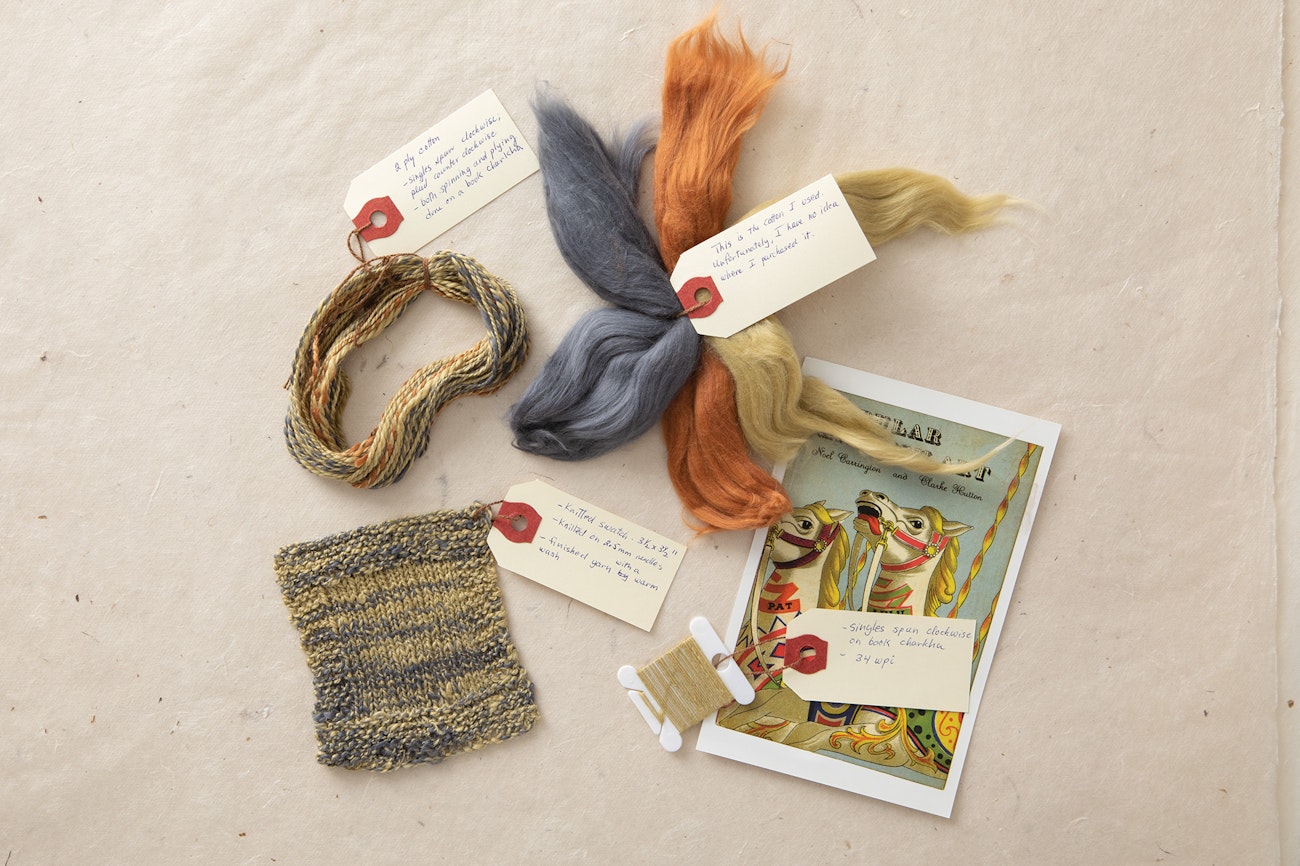 Joanne’s charkha-spun yarns have improved with practice. Photo by Matt Graves
Joanne’s charkha-spun yarns have improved with practice. Photo by Matt Graves
A Shared Skill
I have always felt that community is very much part of any journey, and so it is with my journey to understand charkhas. Their use in Gandhi’s Indian independence efforts marks a historical community. The charkha’s continued use in India brings economic, political, and gender issues to the fore. Other forms of community are wherever spinners learn—workshops, guild meetings, or casual gatherings.
Community is also formed by people who are curious about charkhas when they see them. At many spinning demonstrations, it is the charkha that draws people in to ask questions. When I tell them the wheel ratio is about 50:1, there are gasps of surprise. It is a great beginning to a conversation about handspinning and possibly a first step on their journey with a charkha.
Interested in learning to spin on the charkha? Kate Larson’s course How to Spin on a Charkha is the place to start.
Resources
- “Mahatma Gandhi’s Announcement of a Design Competition, 24th July 1929.” www.gyti.techpedia.in/announcement.
- Mielkes Fiber Arts. “Tahkli Spinning How To.” www.mielkesfiberarts.com/tahkli-spinning-how-to.
- Needham, Joseph. Science and Civilisation in China, Vol. 4, Part 2. Cambridge: Cambridge University Press, 1965.
- Oxford Dictionaries. www.en.oxforddictionaries.com/definition/charkha
- Rohini, S. “Whither Khadi?” Economic and Political Weekly 44, 13 (2009), 12–15. www.jstor.org/stable/40278654.
- Smith, C. Wayne, and J. Thomas Cothren, eds. Cotton: Origin, History, Technology, and Production. New York: John Wiley & Sons, 1999.
- Wilson, Kax. A History of Textiles. Boulder, Colorado: Westview, 1979.
Building Your Charkha Skills
Check out these resources to begin your charkha journey or fine-tune your skills.
- Setup Ruane, Joan. How to Set Up Your Indian Book Charkha, 2014. www.youtube.com/watch?v=SBOYU6gHDu0.
- Spinning Ruane, Joan. Spinning on [an] Indian Book Charkha, 2014. www.youtube.com/watch?v=B4uZu9yNboI.
- Tips Shepard, Mark. Charkha Tips: How to Spin Cotton on Mahatma Gandhi's Spinning Wheel. www.markshep.com/peace/Charkha.html.
- Punis Benfatto, Elaine. Cotton Puni Primer, 2002. http://urbanspinner.typepad.com/urbanspinner/cotton-puni-primer.html.
Further Resources on Spinning Cotton
- How to Spin on a Charkha with Kate Larson, online course
- “3 Tips for Handcarding Cotton”
- “Cotton Bowing for Beginners”
- “4 Ways to Perfect Your Cotton Prep”
- “Spinning in the Himalayas, Part 2: Spinner and Charkha”
Joanne Nakonechny’s passion and curiosity for spinning is rooted in both her fascination with seeing fluff turn into yarn, and her family history. Joanne’s grandmother and father were also spinners.
Originally published January 3, 2020; updated July 4, 2022; updated June 30, 2025.

